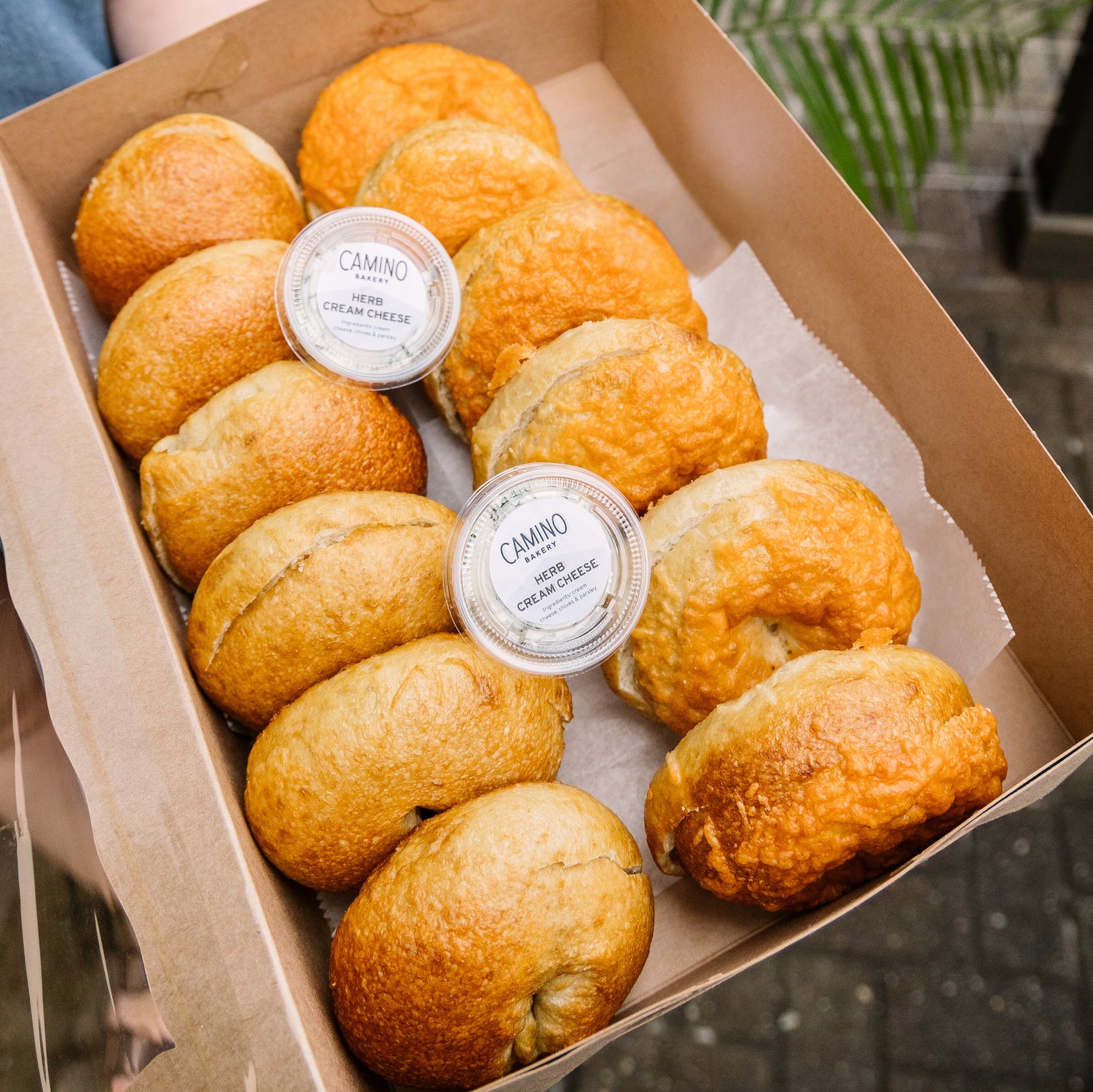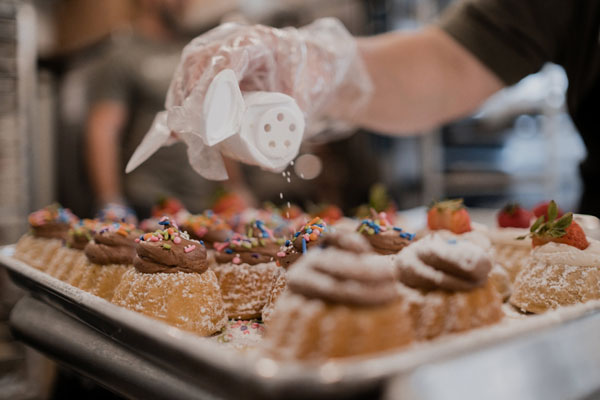Exceptional Catering Maddington Services for Your Following Event
Exceptional Catering Maddington Services for Your Following Event
Blog Article
Understanding the Art of Bakery Products: From Fresh Baked Breads to Irresistible Pastries and Finger Foods
From the science behind the excellent loaf of bread, where fermentation and gluten development play crucial functions, to the skill required for creating layered pastries, each facet reveals an engaging story of craftsmanship. The flexibility of finger foods shows exactly how taste and structure can be skillfully combined to involve diverse taste preferences.
The Science of Bread Making
At the heart of every loaf of bread lies a fascinating interplay of chemistry and biology. The process of bread making starts with the mix of flour, yeast, salt, and water-- each ingredient playing a critical duty in the final product.
Yeast, a living organism, ferments the sugars existing in the flour, generating co2 and alcohol in the process. The co2 gas creates bubbles in the dough, triggering it to climb and develop a light structure. The temperature level and moisture throughout fermentation substantially affect yeast activity and, consequently, the bread's taste and texture.

Learning Pastry Techniques
How can one attain the fragile balance of appearance and flavor that defines outstanding pastry? Understanding pastry strategies calls for a deep understanding of active ingredients, approaches, and the scientific research behind them. Fundamental to this craft is the option of premium active ingredients-- flour, butter, sugar, and eggs-- each playing a critical role in the end product's taste and structure.
The technique of lamination, which entails folding layers of dough and butter, creates the wanted flakiness in pastries like croissants and puff bread. Precision in temperature is essential, as butter must stay cool to ensure ideal layers. Proper blending approaches, such as the creaming method for cakes, make certain even consolidation of air and fat, resulting in a light and airy crumb.
Moreover, preserving the appropriate humidity degrees throughout cooking can considerably affect the outcome, making sure that pastries climb properly and attain that golden-brown finish. The art of bread also demands patience and technique; each attempt boosts one's ability and understanding of the elaborate equilibrium required to create tempting breads that thrill the detects. Proficiency in these methods eventually differentiates a skilled bread chef from an amateur.
Kinds of Finger Foods
The globe of culinary delights extends past breads to incorporate a large variety of finger foods, which are commemorated for their benefit and versatility. These bite-sized deals with are best for celebrations, supplying an array of flavors and appearances that deal with varied palates.

On the sweeter side, bite-sized cupcakes and tiny tarts supply a delightful coating to any type of dish, interesting those with a wonderful tooth. Furthermore, cheese and charcuterie boards function as an innovative selection, allowing visitors to tailor their bites with a selection of meats, nuts, fruits, and cheeses.
Taste Profiles in Cooking
Baking is an elaborate dance of flavor profiles that integrates sweet, savory, and umami notes to develop a harmonious experience for the taste buds. Understanding these profiles is vital for bakers seeking to raise their creations.
Sweet taste typically works as the foundation in baked goods, with sugars, fruits, and all-natural sweeteners boosting flavor deepness. Components such as chocolate and sugar present complicated pleasant notes that can either dominate or complement various other flavors. On the other hand, full-flavored aspects, often discovered in breads and breads, supply balance and comparison. Ingredients like cheeses, natural herbs, and seasonings can change a straightforward dough into a multifaceted flavor experience.
Umami, frequently forgotten in cooking, plays a considerable role in enhancing tastes. Active ingredients such as aged cheeses, fermented products, or also specific nuts add to a mouthwatering depth that boosts total preference.
In addition, the interplay of level of acidity from ingredients like buttermilk or citrus passion can brighten flavors, supplying a refreshing counterpoint to sweet taste. By thoughtfully integrating these taste profiles, bakers can craft items that reverberate with diverse tastes, creating a memorable cooking experience. Inevitably, grasping taste profiles is key to technology on the planet of baking.
Vital Cooking Devices and Components
Recognizing taste profiles in cooking collections the stage for choosing the right tools and components that promote the development of outstanding Recommended Site baked products. The structure of successful cooking hinge on having essential tools at hand. Secret items include blending bowls, determining cups, and spoons for precision, along with a tough stand mixer or hand mixer for easy mixing. A reliable set of cooking frying pans-- such as sheet pans, loaf frying pans, and cake pans-- is essential for accomplishing desired structures and shapes.
Flour offers as the backbone of the majority of recipes; selecting the ideal type-- be it bread, all-purpose, or pastry flour-- can substantially influence the outcome. Cooking powder and baking soda are vital for creating lift in breads and cakes.
In addition, including taste boosters like vanilla remove, flavors, and citrus zest can raise your developments. By ensuring accessibility to these fundamental devices and active ingredients, bakers can with confidence start their culinary journey, crafting a varied array of delightful baked goods.
Verdict
Finally, the art of bakery products encompasses an extensive understanding of both imaginative methods and clinical principles. Proficiency in bread making, bread prep work, and finger food discussion discloses the detailed relationships between procedures and ingredients. In addition, exploring diverse flavor accounts enhances the baking experience, while crucial tools and ingredients offer the foundation for success. Eventually, the captivating world of cooking thrives on the harmonious interaction of scientific research and imagination, causing a myriad of wonderful cooking developments.
Just how can one accomplish the fragile equilibrium of structure and flavor that specifies extraordinary bread? Essential to this craft is the choice of high-grade ingredients-- flour, butter, sugar, and eggs-- each playing an essential duty in the check out here last item's flavor and appearance.

Understanding flavor accounts in baking collections the stage for selecting the right devices and components that facilitate the production of phenomenal baked items. Exploring varied taste profiles enriches the baking experience, while necessary devices and active ingredients supply the structure for success.
Report this page